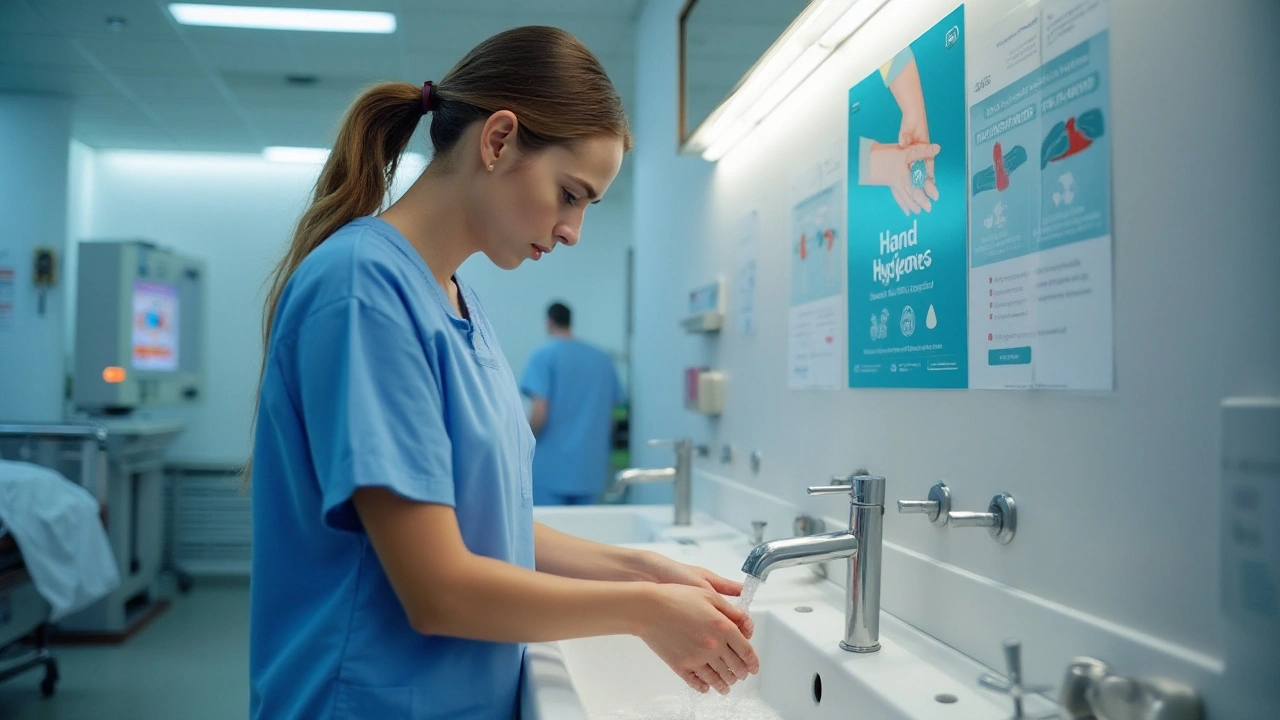
Every day, we engage with our surroundings, often oblivious to the countless microorganisms we encounter, some beneficial, others not so much. Among them, Candida species pose a sneaky threat, known to cause serious infections like candidemia. Hospitals, with their vulnerable patient populations, are particularly sensitive to these infections.
One of the most effective ways to keep these infections at bay is a practice so simple yet so powerful: hand hygiene. Washing our hands thoroughly and regularly is not just about personal cleanliness; it forms the backbone of infection control efforts worldwide. And yet, its significance is sometimes underestimated in the hustle of everyday life.
This article delves into the world of candidemia and disseminated Candida infections, illuminating how such ailments spread and the pivotal role hand hygiene plays in prevention. We will explore practical advice and methods to elevate hand hygiene practices, transforming this simple act into a formidable defense against infections.
Candidemia stands as one of the most serious manifestations of Candida infections, a pervasive challenge in the realm of healthcare. This condition occurs when Candida, a typically benign yeast found in small amounts in the human body, enters the bloodstream, turning a harmless organism into a potential threat. Such infections are particularly prevalent in hospital settings, where patients with weakened immune systems are especially vulnerable. Surprisingly, candida infections have been reported as the fourth most common bloodstream infections in the United States, reflecting their significant impact on patient health.
What makes candidemia particularly treacherous is its elusive nature. Unlike more visible infections, Candida can silently infiltrate the body, leading to a slew of complications if not promptly identified and treated. Symptoms often mimic those of other illnesses, causing delays in diagnosis. Fever, chills, and a general feeling of being unwell are typical, yet ambiguous signs. This often necessitates extensive laboratory testing to isolate the Candida species in question and determine an effective treatment regimen. With mortality rates alarmingly high in untreated cases, understanding the subtle nuances of candida infections becomes crucial for healthcare providers.
The risk factors for candidemia are diverse and commonly linked to invasive medical procedures. Patients with central venous catheters, those undergoing prolonged antibiotic treatments, or individuals with compromised immune functions are at heightened risk. The frequent use of broad-spectrum antibiotics disrupts normal flora, allowing Candida to thrive unchecked. This highlights the importance of judicious antibiotic use and the need for rigorous infection control measures in healthcare facilities. Moreover, a study by the Centers for Disease Control and Prevention underscores that nearly 1 in 4 cases of candidemia occur in people with no identifiable risk factor, making vigilance paramount.
The Infectious Diseases Society of America states, "Early intervention and targeted antifungal therapy are pivotal in reducing the mortality associated with candidemia." This quote serves as a sobering reminder of the critical role that timely, accurate diagnosis plays in battling these infections.
The path to combating these insidious infections lies not only in advanced medical treatments but also in preventive measures. Hand hygiene, as explored in-depth later, emerges as a frontline defense. Educational campaigns targeted at healthcare providers, patients, and the general public are essential, fostering awareness and proactive behavior in tackling candidemia. Only through knowledge, vigilance, and concerted efforts can the genuine challenge posed by candida infections be effectively managed.

The journey of infection often begins innocuously, with microscopic organisms finding a way into the human body. Candidemia, a severe bloodstream infection caused by Candida fungi, usually starts with these organisms residing harmlessly on skin or mucosal surfaces. However, when the body's defenses are down, such as in patients with weakened immune systems or those undergoing surgery, these organisms seize the opportunity to invade.
In healthcare settings, the spread of Candida infections can be alarmingly quick. It can occur through direct contact, where medical personnel inadvertently transfer Candida from one patient to another, often through their hands. Medical equipment and devices, like catheters or ventilators, also serve as potential vehicles for transmission, emphasizing the need for meticulous sanitation protocols. A study from the CDC highlights that "adherence to hand hygiene is among the most important practices in any healthcare setting." These infections flourish in environments where hygiene practices are poor, underscoring the importance of rigorous infection control measures.
Environmental surfaces are not exempt from playing a role in transmission. Surfaces frequently touched by many people, such as door handles, bed rails, or even shared medical equipment, become reservoirs for pathogenic organisms. When a healthcare worker or patient touches these surfaces and subsequently contacts others or themselves, the cycle of infection continues. This is why infection control in medical facilities can often come down to the integrity of hand hygiene
Considering the potent risk factors, individuals with central venous catheters, those receiving antibiotics, or belonging to high-risk groups are particularly vulnerable. Instituting strict measures, like isolating infected individuals and ensuring robust sanitation, becomes vital. Prevent, isolate, sanitize—these are key tactics that help halt the cycle of transmission. The role of each individual—patients and healthcare providers alike—in adhering to hand hygiene protocols cannot be overstated, as it significantly diminishes the risk of widespread infections.

Waging war against infections like candidemia often starts with the most humble of actions—washing our hands. The importance of hand hygiene cannot be overstated when we consider the chain of infection. Most infections, including those caused by Candida species, spread through direct or indirect contact. Hospitals and healthcare facilities, bustling with activity, are environments where infections can easily spiral out of control. Here, every surface touched by hands becomes a potential breeding ground for these microorganisms to thrive and spread. More than just a personal measure, good hand hygiene practices become a collective shield against these invisible invaders.
Handwashing isn't just a quick rinse under running water; it's a comprehensive process that involves several steps to ensure effectiveness. Water alone isn’t enough to remove the wide array of germs our hands encounter daily. Soap is crucial as it helps to lift dirt and microorganisms off the skin. The friction created by rubbing hands together is a mechanical process that ensures these pathogens get dislodged and rinsed away. Guidelines from health organizations recommend scrubbing all parts of the hands, including the backs, between the fingers, and under the nails, which are typical germ traps. This process should last at least 20 seconds to be effective, yet many people often shortchange this crucial step.
In the words of the World Health Organization, "Hand hygiene is the single most important measure to prevent the transmission of bacteria and viruses and reduce infections in healthcare settings."
Sometimes, despite knowing its importance, hand hygiene takes a backseat either due to complacency or sheer forgetfulness. In clinical settings, this oversight can be significant and chart a direct path to nosocomial infections—those acquired in hospitals. When looking at preventing diseases such as candidemia, the focus sharpens even more. These fungal infections can be extremely serious, leading not just to discomfort but potentially life-threatening conditions. Herein lies the power of handwashing—and not just any handwashing, but effective and regular practices that become second nature in our daily lives.
The inclusion of alcohol-based hand sanitizers has further enhanced the arsenal against infections. These sanitizers are particularly useful when soap and water are not readily available. Effective against a variety of pathogens, including certain strains of Candida, hand sanitizers offer a quick and reliable method to maintain hygiene. It’s essential, however, to use products that contain at least 60% alcohol as the efficacy largely depends on this concentration. Still, whenever feasible, washing hands with soap and water is preferred, primarily when hands are visibly dirty or greasy.
Health tips often revolve around tangible lifestyle changes, but over time, one learns that it's these small habitual practices that pack a powerful punch when it comes to preventing infections. Teaching hand hygiene to children, encouraging its practice at workplaces, and integrating frequent reminders in everyday routines can collectively build a barricade against infections. A well-implemented hand hygiene program within a community or a healthcare facility not only reduces the risk of infections but also elevates the overall standard of public health.

Effective handwashing is a simple yet powerful weapon against infections like candidemia. Despite its simplicity, there are very specific techniques recommended by health authorities for ensuring that hand hygiene is indeed effective. To start with, it's crucial to use clean, running water, whether warm or cold. Studies have shown that the temperature of the water doesn’t impact effectiveness, but what truly matters is the duration and thoroughness of the wash. Wet your hands before applying soap, which can be liquid, bar, or powdered. Surprisingly, the type of soap, whether antibacterial or just plain, doesn’t make a significant difference in terms of efficacy against daily pathogens.
“Clean hands are all about technique – spend the time scrubbing, not worrying about minor factors,” reminds the Centers for Disease Control and Prevention.
Once hands are wet and soaped, lather by rubbing them together vigorously. Soap acts as a surfactant and helps to remove dirt, oils, and microbes physically. Proper lathering involves scrubbing all surfaces, which includes not just the palms but also the back of the hands, between fingers, and under the nails where pathogens can cling. This should be done for at least 20 seconds, about the time it takes to hum the “Happy Birthday” song twice. An oft-overlooked technique is scrubbing under the fingernails where Candida can dwell; using a nail brush occasionally might help ensure this area is clean.
After scrubbing, rinse out all the soap under clean running water. Some might be surprised, but leaving soap on the hands can cause irritation or discomfort over time. It’s best to keep rinsing for as long as lathering time is spent. When it comes to drying, which is another overlooked step, using a clean towel or air drying is suggested. Damp hands spread bacteria faster than dry ones, emphasizing the need to finish the process properly. Additionally, avoid touching the faucet or the door handle right after washing. Some advocate using a paper towel to turn off the tap or open doors if possible.
Practicing these recommended techniques significantly reduces the chance of spreading infections such as candidemia. A study conducted in hospital settings showed a 30% reduction in infection when proper hand hygiene was emphasized among healthcare workers. While this all might seem routine to some, the impact of thorough hand hygiene can be profound, especially in environments where individuals at risk are present. Seconds spent washing your hands properly can significantly reduce the risk of transmission of both hospital-acquired and community infections.
Hand hygiene is not only about self-protection; it is a shared responsibility for the community and public health at large. By practicing effective handwashing, individuals contribute to the reduction of disease dissemination, thereby safeguarding themselves and those around them. In healthcare settings or at home, remember that regular and thorough handwashing is always a worthwhile habit.
Stephen Wunker
23 01 25 / 08:16 AMEveryone acts like hand‑washing is the ultimate halo, but the truth is it’s just a ritual that masks deeper systemic failures in hospitals. We glorify the act while ignoring how understaffed wards let pathogens roam. If you really want to stop candidemia, you need to overhaul staffing ratios, not just scrub your palms. The focus on soap creates a false sense of security, letting institutions dodge accountability. In the grand scheme, hygiene is a band‑aid on a bullet wound.
Jhoan Farrell
23 01 25 / 09:00 AMI feel you, man – the endless hustle can make a 20‑second wash feel like a chore 🙌. But think of every patient who could be saved with just a quick scrub. 😃 A little extra time now means a lot less suffering later. Keep those hands clean, it’s a tiny act of love for everyone around you.
Jill Raney
23 01 25 / 10:00 AMWhile the mainstream pushes the narrative that hand hygiene is the silver bullet, one must wonder who profits from this oversimplification 🤔. The pharmaceutical lobby thrives on the fear of “invisible” infections, turning basic hygiene into a marketable scare tactic. Behind the glossy posters lie deeper power dynamics, and the average nurse becomes a pawn in a grander scheme. 🕵️♀️ Keep your eyes open; the truth is often hidden beneath the suds.
bill bevilacqua
23 01 25 / 11:00 AMGuys... the whole hand‑wash thing? Overrated!!! If you spend more time washing than actually treating patients, you’re just feeding the system... Honestly, who even reads those manuals??? Let’s be real, politics > soap.
rose rose
23 01 25 / 12:00 PMThe germs are a government test, wash or suffer.
Emmy Segerqvist
23 01 25 / 13:00 PMOh my God!!! The sheer drama of a single hand rub can change the fate of an entire ward!!! Imagine the applause if every nurse treated hand‑hygiene like a Broadway finale!!! 🎭✨
Trudy Callahan
23 01 25 / 14:00 PMIn the quiet moments between patient rounds, one can contemplate the paradox of cleanliness: we strive to eradicate the microscopic, yet our own habits become the very conduit for their survival. It is a dance of intention and oblivion, where each wash carries the hope of redemption.
Grace Baxter
23 01 25 / 15:00 PMSure, hand‑washing is praised, but let’s not pretend it’s the only shield against a fungal invasion. In my view, the real threat is the complacency of administrations that think a splash of water equals safety. We need robust surveillance, not just a ritualistic lather. And frankly, the hyper‑nationalist agenda pushing “our hospitals are the best” ignores the fact that germs don’t respect borders. So, while we dutifully scrub, let’s also demand systemic accountability.
Eddie Mark
23 01 25 / 16:00 PMYo the vibe in the break room when someone forgets to wash is kinda wild but we all just roll with it like it’s no big deal bro the colors in the soap make it kinda fun and honestly i think the world needs more chill vibes and less panic about germs
Caleb Burbach
23 01 25 / 17:00 PMHand hygiene is more than a habit; it’s a promise we make to every patient walking through our doors. 🌟 By taking those extra 20 seconds, we give life a fighting chance against cunning foes like Candida. Think of each wash as a tiny beacon of hope, shining in the corridors of care. When we scrub correctly, we break the chain of transmission, protecting the vulnerable and honoring our professional oath. Studies show that diligent hand‑washing can cut infection rates by nearly a third – that’s a tangible impact we can all see. 🌈 Let’s celebrate those small victories, because they add up to massive change. 👐 Remember, clean hands are the first line of defense, not a bureaucratic checkbox. 💪 Embrace the routine, teach it to colleagues, and keep the momentum alive. Together we forge a culture where safety feels natural, not forced. 🤝 Keep the momentum going, and let every hand wash be a step toward a healthier tomorrow. 🌍✨
Danica Cyto
23 01 25 / 18:00 PMBeyond the suds lies a deeper symbolism: each wash reflects a fleeting attempt to cleanse not just skin but moral responsibility. If we neglect the microscopic, we betray the very essence of caregiving.
Raja M
23 01 25 / 19:00 PMHey there! I totally get that remembering to wash can feel like just another task, but imagine the relief on a family’s face when they know their loved one is protected. A simple splash can be a huge act of kindness. Let’s keep the vibe positive and make hand hygiene a habit we’re proud of.
Rob Flores
23 01 25 / 20:00 PMAh, the grand parade of hand‑washing guidelines – how delightfully predictable. One might wonder if the real infection we’re battling is the monotony of these endless memos.
Shiv Kumar
23 01 25 / 21:00 PMFrom a strategic standpoint, the emphasis on hand hygiene appears commendable; however, a nuanced analysis suggests that without concurrent investment in staffing and infrastructure, the measure may prove superficial.
Ryan Spanier
23 01 25 / 22:00 PMIt is essential that we, as a team, adopt a consistent hand‑hygiene protocol. I encourage each member to lead by example and remind peers when lapses occur. Together, we can sustain a safe environment for all patients and staff.
Abhinav Moudgil
23 01 25 / 23:00 PMLet’s channel our energy into making hand hygiene a dynamic part of daily routines! 🌟 Imagine a workplace where each scrub feels like a power‑up in a game – energizing, purposeful, and rewarding. By setting clear reminders and celebrating compliance, we can turn a simple act into a collective triumph. 🚀
Miah O'Malley
24 01 25 / 00:00 AMImagine the ripple effect when every staff member treats hand hygiene as an act of community stewardship. The conversation becomes lively, the engagement grows, and the collective vigilance creates a culture where infections find no foothold.